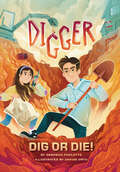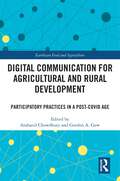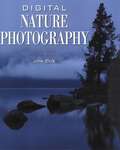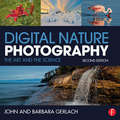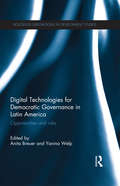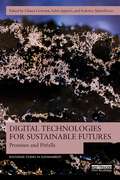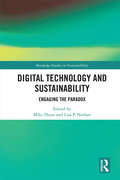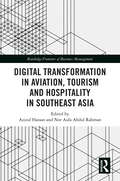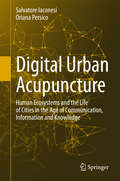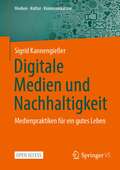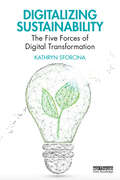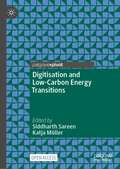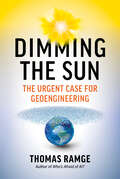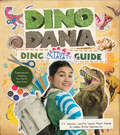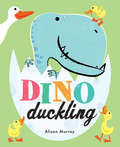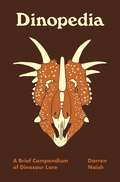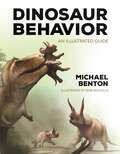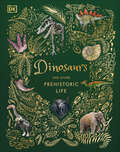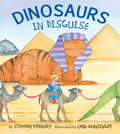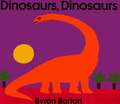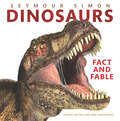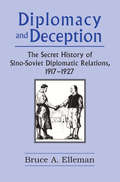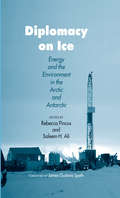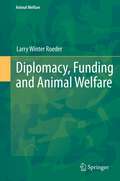- Table View
- List View
Digger: Dig or Die!
by Deborah CholetteIn this dystopian middle-grade novel, a climate change disaster forces humanity to flee as Earth's atmosphere escapes into space. Narrated by siblings Nick and Lily, the story follows their resourcefulness in aiding neighbors. Nick's digging prowess and Lily's strategic planning become vital as oxygen diminishes. Nick unveils a hidden tunnel connecting houses, forming a lifesaving network as breathable air dwindles. Lily crafts a communication system with walkie-talkies and baby monitors to share critical information. A frantic race ensues to complete the tunnels before food and oxygen become scarce, a tense battle for survival in a world teetering on the brink.
Digital Communication for Agricultural and Rural Development: Participatory Practices in a Post-COVID Age (Earthscan Food and Agriculture)
by Gordon A. GowThis volume presents insights on the challenges of digital communication and participation in agricultural and rural development. The COVID-19 pandemic has revealed that digital technology and mediated participation is more important and essential in managing ongoing communication for development projects than ever before. However, it has also underscored the various challenges and gaps in knowledge with digital participatory practices, including the further exclusion of marginalized groups and those with limited access to digital technology. The book considers how the concept of participation has been transformed by the realities of the pandemic, reflecting on essential principles and practical considerations of communication for development and social change, particularly in the context of global agriculture and food security, the well-being of rural communities, and evolving environmental challenges, such as climate change. In gathering these insights, this volume highlights lessons for the future of participatory development in communication for development and social change processes. This volume will be of great interest to students and scholars of agricultural and rural development, communication for development, digital communication, and sustainable development more broadly.
Digital Nature Photography
by Jon CoxDigital Nature Photography is the definitive how-to book on photographing nature with a digital camera. Focusing primarily on the art of taking the picture in the field--rather than just manipulating the image after it has been shot--this comprehensive guide is geared to the nature photographer who is fairly new to the world of digital cameras. Packed with step-by-step directions and resplendent full-color examples from the author's own body of work, readers will receive hands-on practice with lighting, composition, landscapes, sunrises, sunsets, animal portraits, close-ups, manipulating and storing images, and much more. The essential reference for every level of photographer, Digital Nature Photography guides the reader through a magnificent and unique visual experience into the natural world.
Digital Nature Photography: The Art and the Science
by John and GerlachIdentifying a beautiful image in nature is easy, but capturing it is often challenging. To truly seize the essence of a photograph shot out of the studio and in the world requires an artistic eye and impeccable set of photographic techniques. John and Barbara Gerlach have been teaching photographers how to master the craft of photographing nature and the outdoors through their workshops and best-selling books for more than twenty years. Now, equipped with brand new images to share and skills to teach, this celebrated photo team is sharing their latest lessons in the second edition of Digital Nature Photography. Notable revisions in this new edition include introducing the concepts of focus stacking and HDR, as well as expanded discussions of multiple exposure, wireless flash, RGB histograms, live view, shutter priority with auto ISO, hand-held shooting techniques, and the author’s equipment selections. The inspiring imagery in this book covers a broader range of subjects than before including ghost towns, the night sky, animals, and sports, in addition to the classic nature photographs we expect from this very talented author team. This book is a comprehensive guide to one of the broadest subjects in photography, explained and dymystified by two respected masters.
Digital Technologies for Democratic Governance in Latin America: Opportunities and Risks (Routledge Explorations in Development Studies)
by Yanina Welp Anita BreuerThis book is the first to comprehensively analyse the political and societal impacts of new Information and Communication Technologies (ICT) in a region of the Global South. It evaluates under what conditions some Latin American governments and people have succeeded in taking up the opportunities related to the spread of ICTs, while others are confronted with the pessimist scenario of increased, digitally induced social and democratic cleavages. Specifically, the book examines if and how far the spread and use of new ICT affected central aims of democratic governance such as reducing socio-economic and gender inequality; strengthening citizen participation in political decision making; increasing the transparency of legislative processes; improving administrative processes; providing free access to government data and information; and expanding independent spaces of citizen communication. The country case and cross-country explore a range of bottom-up driven initiatives to reinforce democracy in the region. The book offers researchers and students an interdisciplinary approach to these issues by linking it to established theories of media and politics, political communication, political participation, and governance. Giving voice to researchers native to the region and with direct experience of the region, it uniquely brings together contributions from political scientists, researchers in communication studies and area studies specialists who have a solid record in political activism and international development co-operation.
Digital Technologies for Sustainable Futures: Promises and Pitfalls (Routledge Studies in Sustainability)
by Chiara Certomà Fabio Iapaolo Federico MartellozzoThis book critically examines the interplay between digitalization and sustainability. Amid escalating environmental crises, some of which are now irreversible, there is a noticeable commitment within both international and domestic policy agendas to employ digital technologies in pursuit of sustainability goals.This collection gathers a multitude of voices interrogating the premise that increased digitalization automatically contributes to greater sustainability. By exploring the planetary links underpinning the global digital economy, the book exposes the extractive logics ingrained within digital capitalism and introduces alternatives like digital degrowth and the circular economy as viable, sustainable paths for the digital era. Through a combination of theoretical reflections and detailed contextual analyses from Italy, New Zealand, and the UK—including initiatives in participatory planning and technology co-design—it articulates the dual role of digital technology: its potential to support socio-economic and environmental sustainability, while also generating conflicts and impasses that undermine these very objectives. Offering fresh insights into power disparities, exclusionary tactics, and systemic injustices that digital solutionism fails to address, this volume also serves as a reminder that sustainability extends beyond climate-related issues, underscoring the inseparability of environmental discourse from wider social justice considerations.Aimed at a diverse readership, this volume will prove valuable for students, researchers, and practitioners across various fields, including Geography, Urban Studies, Sustainability Studies, Environmental Media Studies, Critical AI Studies, Innovation Studies, and the Digital Humanities.
Digital Technology and Sustainability: Engaging the Paradox (Routledge Studies in Sustainability)
by Mike Hazas Lisa NathanThis book brings together diverse voices from across the field of sustainable human computer interaction (SHCI) to discuss what it means for digital technology to support sustainability and how humans and technology can work together optimally for a more sustainable future. Contemporary digital technologies are hailed by tech companies, governments and academics as leading-edge solutions to the challenges of environmental sustainability; smarter homes, more persuasive technologies, and a robust Internet of Things hold the promise for creating a greener world. Yet, deployments of interactive technologies for such purposes often lead to a paradox: they algorithmically "optimize" heating and lighting of houses without regard to the dynamics of daily life in the home; they can collect and display data that allow us to reflect on energy and emissions, yet the same information can cause us to raise our expectations for comfort and convenience; they might allow us to share best practice for sustainable living through social networking and online communities, yet these same systems further our participation in consumerism and contribute to an ever-greater volume of electronic waste.By acknowledging these paradoxes, this book represents a significant critical inquiry into digital technology’s longer-term impact on ideals of sustainability. Written by an interdisciplinary team of contributors this book will be of great interest to students and scholars of human computer interaction and environmental studies.
Digital Transformation in Aviation, Tourism and Hospitality in Southeast Asia (Routledge Frontiers of Business Management)
by Azizul Hassan and Nor Aida Abdul RahmanTechnological advances and the drive to digitalize business processes in aviation, tourism, and hospitality have forced the industries to go along with the digital movement. The results are often mixed. This book brings together contributions from leading scholars in the field and explores the digital transformation in these industries in Southeast Asia. The book looks at the impact of digital transformation on the region and the issues and challenges brought about by this transformation. It also addresses trends in the industries from blockchain technology, AI, biometric and mobile technology applications to in-flight catering. It examines the impact of COVID-19 on the industries and how the pandemic has led to businesses adopting new business models. Through the case studies of digital adoptions in the region, readers will gain insights on how the countries have leveraged new technologies and the implementation processes to drive digital transformation. The book aims to help scholars and policy makers understand the digital advances in the industries to better formulate responses in research and policy making and deliver effective digital transformation.
Digital Urban Acupuncture
by Salvatore Iaconesi Oriana PersicoThis book explores the possibility to observe the lives of cities through ubiquitous information obtained through social networks, sensors and other sources of data and information, and the ways in which this possibility describes a new form of Public Space, which can be used to define new forms of citizenship and participated city governance. The work is the result of years of research across sciences, arts, design, ethnography, cultural geography, performed by multiple researchers, understanding the Relational Ecosystems of cities (the flows of relation, information, knowledge and emotion in the city) and using them to reinterpret the concept of Urban Acupuncture: from the Third Space, Third Landscape and Third Generation City, to the Third Infoscape; from Urban Acupuncture to Digital Urban Acupuncture. The book starts by exploring the many theories and methodologies which have been used to try to capture and use the revolutionary potential found in the daily lives of cities. From De Certeau, to Latour, Bateson, Bhabha, and all the way to Castells, Clèment, Boyd, Casagrande. In a progression which moves from the Third Space (Soja, De Certeau), to the Third Landscape (Clèment), to the Third Generation City (Casagrande), to the Third Paradise (Pistoletto), the book arrives at a definition of the Third Infoscape, following up on Kevin Lynch: a new legibility and imageability of the city. Its main themes and objectives lie in the desire to observe and understand the radical transformation of the definitions, boundaries and configurations of what we call public and private spaces, in different cultures and communities, in the age of communication, information and knowledge, and to use these understandings to formulate a set of working hypotheses for the positive, constructive, active and participatory usage of these transformed scenarios, contributing to the re-definition of concepts such as citizenship, city-governance, urban planning, civic decision-making, and more. And using, in the process, techniques such as Urban Acupuncture, Actor-Network Theory, Diasporic analysis, Peer-to-peer Urbanism and more. Multiple real-life research scenarios and documented case studies will be used, from 4 continents, coming from our research and from other international contributions.
Digitale Medien und Nachhaltigkeit: Medienpraktiken für ein gutes Leben (Medien • Kultur • Kommunikation)
by Sigrid KannengießerWie nutzen Individuen, Nichtregierungsorganisationen und Unternehmen digitale Medien, um zu einer nachhaltigen Gesellschaft beizutragen? Die Autorin rekonstruiert in dieser Open-Access-Publikation die sozial-ökologischen Folgen aktueller Digitalisierungsprozesse und zeigt anhand dreier Fallstudien, wie verschiedene Akteur*innen Digitalisierung nachhaltiger gestalten (wollen): Neben dem Reparieren von Medientechnologien in Repair Cafés wurde die Produktion und Aneignung fairer Medientechnologien am Beispiel des Fairphones untersucht sowie Onlineplattformen, die für nachhaltigen Konsum werben, am Beispiel von utopia.de. Sind dies Beispiele für Medienpraktiken, die das Ziel der Nachhaltigkeit verfolgen, so werden in der vergleichenden Analyse auch Grenzen und Ambivalenzen dieses Handelns offenbar.
Digitalizing Sustainability: The Five Forces of Digital Transformation
by Kathryn SforcinaDigitalizing Sustainability outlines why ‘business as usual’ isn't working and sets out five Transformational Forces which can be used to innovate and scale sustainability solutions using digital means. This transformation will be powered by a range of digital technologies that have the potential to ideate, propel and scale sustainability solutions in an exponential manner over the next decade. This book introduces the Five Forces of Digital Transformation. These forces all share a common root – they are powered by digital technologies that enable them to operate at the speed and scale that we need to achieve global transformation for people and planet. Working together, these forces help overcome many of the barriers and pitfalls that humanity has faced in trying to achieve sustainability 2.0 and will help you tackle these questions: Why has sustainability 1.0 failed us? What are the bugs and bad code in our operating systems that we must address to have any hope of creating a sustainable civilization? What are the Five Forces of Digital Transformation that will forge a sustainable and resilient future for our people and planet? What are the core priorities going forward for coalitions of the willing to harness these forces for sustainability and resilience? Disruptive and innovative, this book provides readers with a clear path forward to a sustainable digital future. It will be of great interest to anyone interested in the adoption of digital technologies for driving solutions to global sustainability challenges.
Digitisation and Low-Carbon Energy Transitions
by Siddharth Sareen Katja MüllerThe world is digitising as the need for low-carbon transitions gains urgency. Decarbonising energy requires the digital process control of energy production, transmission and end use. Diversified electrification across sectors requires real-time digital coordination of distributed energy production, At the same time, digitisation is accompanied by significant increases in energy demand, partly compensated through energy efficiency gains.The emergent linkages between digitisation and decarbonisation – that constitute and enable the twin transition – are the subject of this book. The collection features authors from across the social sciences who situate digitisation and low-carbon energy transitions in the socio-technical and political economic contexts in which they unfold, to offer insights on the dynamics and contingencies of digitisation in and beyond the energy sector.This is an open access book.
Dimming the Sun: The Urgent Case for Geoengineering
by Thomas RamgeA groundbreaking, vital examination of a powerful—and extremely controversial—stopgap solution to looming climate catastrophe “It would be great if humanity could forgo solar geoengineering and get climate change under control before the world goes off the rails. But I no longer believe in this possibility.” Earth stands at a tipping point. As we fail to curtail emissions fast enough, our planet stares down a cascade of imminent, catastrophic, and irreversible disaster triggered by climate change. Yet a potent technology already exists to buy us more time: solar geoengineering. Through methods such as atmospheric aerosols, human-generated cirrus clouds, and solar sails, we humans can—at least in the short term—slow the Earth’s warming. Should we? Award-winning science writer Thomas Ramge’s Dimming the Sun is his provocative, informative, urgent, and necessary exploration of this intriguing stopgap solution. Ramge shows us how the science works, what the risks are—both geophysical and political—and how the international community might come together to agree on and regulate a safe and effective plan for geoengineering. And while he identifies the unknowns about the technology that remain, he believes this very uncertainty demands our full attention. With time to avert the worst of climate change rapidly running out, he makes a forceful case that the most responsible course of action is to dramatically increase research on solar geoengineering now—before it’s too late.
Dino Dana Dino Activity Guide: Experiments, Coloring, Fun Facts and More (Dino Dana Ser.)
by J.J. Johnson Christin Simms Colleen Russo Johnson Alexis GrieveThe third in the Dino Field Guide series, Dana is passing on her field guide to a new paleontologist in training, you! The Dino Dana Activity Guide is filled with new dino experiments, Dana’s craft ideas, and other exciting activities to help young dino fans uncover more about their favourite prehistoric creatures. Dinosaur Coloring Book Field Guide with Fun Facts and Find-a-Word Activities#1 New Release in Fossils, Dinosaurs, and ZoologyMy First Dinosaur Field Guide is a field guidebook for kids that introduces dinosaurs, fossils, and archeological experiments. Discover a dinosaur on every page. Join Dino Dana as she builds friendships with a Tyrannosaurus Rex, Stegosaurus, and a Triceratops. Fans of the Amazon Prime TV show from the incredible show's creator and executive producer, J. J. Johnson; developmental scientist, Colleen Russo Johnson, PhD; and Emmy-winning producer Christin Simms, will love having this colorful field guide to follow Dino Dana on her adventures. Larn about 36 different dinosaurs, such as the Brachiosaurus, Kosmoceratops, and Spinosaurus. This field guide features word searches, fact-finder fill-ins to color, and search and finds. Your little paleontologist will be delighted.Have fun coloring, finding facts, and pasting your own dino creations right into the pages. Your child will learn about what Triceratops ate, how long a T-Rex arms were, and how many teeth a Stegosaurus had.A great science book for kids. This book for children is perfect for any kid who likes history and science. In My First Dinosaur Field Guide, your kids will learn:That the Brachiosaurus was the tallest dinosaur that we know of todayThat the Kosmoceratops had fifteen horns and hooks on its headThat the Spinosaurus is the only known dinosaur to spend most of its time swimmingAnd so much moreKids who like dinosaur books like We Don't Eat Our Classmates;Hello,World! Dinosaurs;or(DK) Dinosaur! will love My First Dinosaur Field Guide.
Dino Duckling
by Alison MurrayIn this fun and endearing celebration of differences, a dinosaur finds a home with a family of ducks--a fresh twist on the beloved "The Ugly Duckling" tale.Even as an egg, Dino Duckling is different from all the other baby ducks. And when he's born, no one seems to notice that he's actually a dinosaur! Mama Duck knows that there is plenty of room for difference in a loving family, but there's one big problem: How will Dino Duckling fly south for the winter without any wings? Can Dino Duckling ever truly belong? Alison Murray's heartwarming reinvention of a classic is perfect for anyone who has ever wondered how to fit in.
Dinopedia: A Brief Compendium of Dinosaur Lore (Pedia Books #5)
by Darren NaishAn illuminating and entertaining collection of dinosaur facts, from A to ZDinopedia is an illustrated, pocket-friendly encyclopedia of all things dinosaurian. Featuring dozens of entries on topics ranging from hadrosaur nesting colonies to modern fossil hunters and paleontologists such as Halszka Osmólska and Paul Sereno, this amazing A–Z compendium is brimming with facts about these thrilling, complex, and sophisticated animals.Almost everything we know about dinosaurs has changed in recent decades. A scientific revolution, kick-started in the late 1960s by astounding new discoveries and a succession of new ideas, has shown that these magnificent creatures were marvels of evolution that surpassed modern reptiles and mammals in size, athletic abilities, and more. Darren Naish sheds invaluable light on our current, fast-changing understanding of dinosaur diversity and evolutionary history, and discusses the cultural impacts of dinosaurs through books, magazines, and movies. Naish also shows how our emerging view of these animals is very much a human story about ambition and competing egos, revealing that controversy and disagreement are commonplace in the vigorous field of dinosaur studies.With a wealth of original illustrations by the author, Dinopedia is an informative and entertaining collection of lore for the dinosaur lover in all of us.Features a real cloth cover with an elaborate foil-stamped design
Dinosaur Behavior: An Illustrated Guide
by Michael J. BentonA stunningly illustrated guide to these extraordinary creatures from a world-renowned paleontologistPaleobiology has advanced from a speculative subject to a cutting-edge science. Today, researchers are applying the latest forensic technologies to the fossil record, revealing startling new insights into the lives of dinosaurs. This illustrated guide explores the behavior, evolution, physiology, and extinction of dinosaurs, taking readers inside the mysterious world of these marvelous animals. With specially commissioned illustrations by Bob Nicholls, Dinosaur Behavior explains how the dinosaurs lived and courted, fought and fed, signaled and interacted with each other, and much more.Features a wealth of breathtaking illustrations throughoutOffers new perspectives on the prehistoric world inhabited by dinosaursSheds light on how dinosaurs actually looked, how they moved, and how fast they ranExplains the feeding habits of carnivores, herbivores, scavengers, and solitary huntersDiscusses sight, hearing, smell, spatial orientation, and intelligenceBrings to life the social behavior of dinosaurs, from mating and parenting to herd dynamics and migrationTakes readers behind the scenes of the latest, most thrilling discoveries
Dinosaurs and Other Prehistoric Life (DK Children's Anthologies)
by Professor Anusuya Chinsamy-TuranA comprehensive pocket guide to dinosaurs and prehistoric animals and the world they inhabited millions of years ago. Packed with more than seven hundred full-color illustrations, this definitive pocket guide paints a vivid portrait of extraordinary dinosaurs and prehistoric animals, and the ecosystems they lived in millions of years ago. This guide features authoritative text, crystal-clear illustrations, and a straightforward approach to revealing the fascinating lives and habitats of dinosaurs, pterosaurs, marine reptiles, and prehistoric beasts. The introductory section explains classification systems, geological timelines, the evolution of the dinosaurs, and how fossils form and are discovered by paleontologists. For ease of reference, the main body of the book is divided into three sections: the Precambrian and Paleozoic eras, when animals first began evolving; the Mesozoic era, which saw the flourishing and eventual extinction of the dinosaurs; and the Cenozoic era, when giant mammals walked the Earth. Each section is broken down into its geological time periods, and, within these, the species are organized according to habitat--whether they lived on land, in the water, or in the air.There are detailed profiles of 200 dinosaurs and other ancestors of modern animals. Each entry combines a precise, jargon-free description with full-color illustrations, skeletons, and replica models, annotated to showcase the unique features of the species. Maps show where each animal's fossils have been found, and many profiles are supported by photographs to show actual excavation sites.
Dinosaurs in Disguise
by Stephen Krensky Lynn MunsingerFrom ancient Egypt to medieval jousts, from office jobs to grocery shopping, one boy reimagines the modern world with dinosaurs in hiding. This fun, light read will tickle readers’ funny bones while subtly introducing themes of conservation and stewardship, inspiring children to question the world around them.
Dinosaurs, Dinosaurs (Fountas & Pinnell LLI Blue: Level G)
by Byron Barton<p>For the dinosaur-obsessed kid in your life! <p>With bright, clear illustrations and accompanying straightforward text, Dinosaurs, Dinosaurs captures the thrill that children experience as they learn about these prehistoric creatures. <p>With a masterful use of color, shape, and composition, Byron Barton brings to life a unique and endearing vision of what the world may have looked like once upon a time when these beasts still roamed the earth. <p>A bright and fun introduction to dinosaurs that works for the youngest of readers.</p>
Dinosaurs: Fact and Fable
by Seymour Simon“If you love dinosaurs, you’ll love this book."— Steve Brusatte, paleontologist at the University of Edinburgh and New York Times bestselling author of The Rise and Fall of the DinosaursJoin award-winning science writer Seymour Simon as he separates fact from fiction in a brilliant exploration of some of the most fascinating creatures to ever roam the planet: dinosaurs! This nonfiction picture book is an excellent choice for both shared and independent reading during homeschooling and classroom learning, in particular for children ages 6 to 8.Scientists have dug up and uncovered many facts about dinosaurs—and in the process, they have come across many myths. This picture book digs deep into the Age of Dinosaurs, covering topics such as fossilization, plate tectonics, dinosaur diets, paleontology, extinction theories, dinosaur relatives, and more!Get ready to learn what we know about dinosaurs and what we still don’t know, and about the amazing new discoveries being made every single day.Perfect for young scholars’ school reports, Dinosaurs: Fact and Fable features clear text, vibrantly colored pages, engaging sidebars, and stunning full-color illustrations and photographs. This book includes an author's note, a glossary, a timeline, and an index and supports the Common Core State Standards.Check out these other Seymour Simon books about animals:Big CatsButterfliesCatsCrocodiles & AlligatorsDogsDolphinsElephantsFrogsGorillasHorsesInsectsPenguinsSea CreaturesSnakesSpidersWhalesWild BabiesWolves
Dinosaurs: Over 100 Questions and Answers to Things You Want to Know
by Dan Abnett Nik VincentDid the dinosaurs have armor? Were dinosaurs good parents? Why did the dinosaurs become extinct? Dinosaurs How big were the dinosaurs? Where in the world did the dinosaurs live? You'll find the answers to these and over 100 other intriguing questions inside this beautifully illustrated book.
Diplomacy and Deception: Secret History of Sino-Soviet Diplomatic Relations, 1917-27
by Bruce EllemanDuring the Soviet period the USSR conducted diplomatic relations with incumbent regimes while simultaneously cultivating and manipulating communist movements in those same countries. The Chinese case offers a particularly interesting example of this dual policy, for when the Chinese Communists came to power in 1949, their discovery of the nature of Moscow's imperial designs on Chinese territory sowed distrust between the two revolutionary powers and paved the way to the Sino-Soviet split.Drawing on newly available documents from archives in China, Taiwan, Russia, and Japan, this study examines secret agreements signed by Moscow and the Peking government in 1924 and confirmed by a Soviet-Japanese convention in 1925. These agreements essentially allowed the Bolsheviks to reclaim most of tsarist Russia's concessions and privileges in China, including not only Imperial properties but also Outer Mongolia, the Chinese Eastern Railway, the Boxer Indemnity, and the right of extraterritoriality. Each of these topics is analyzed in this volume, and translations of the secret protocols themselves are included in a documentary appendix. Additional chapters discuss Sino-Soviet diplomacy and the parallel history of Soviet relations with the Chinese Communist Party as well as the origins and purpose of the United Front policy.
Diplomacy on Ice
by James Gustave Speth Rebecca H Pincus Saleem H AliAs the race for resources in distant parts of the planet gathers momentum, most discussion has centered on the potential for conflict, environmental destruction, and upheaval from climate change. This important book shifts the conversation about the Arctic and Antarctic from conflict to cooperation. A multidisciplinary roster of experts provides fresh views of the polar regions, focusing on diplomacy and the potential for cooperative international decision-making. Collectively the contributors illustrate the breadth of issues that complicate governance in the Arctic and Antarctic, as well as parallels and differences between the politics of the two poles.
Diplomacy, Funding and Animal Welfare
by Larry Winter Roeder Jr.Diplomacy, Funding and Animal Welfare is a practical guide to the best diplomatic and negotiation practices needed to convince governments and international institutions to effectively protect animals, which also introduces new approaches to fundraising. Animal protection advocates are prepared for speaking to diplomats and government officials in any setting, and to combatants in war zones. The book mainly focuses on approaching local and national governments, the United Nations system, the international Red Cross movement and systems related to other international organizations that can help animals, often in surprising ways. The reader will learn the rules of "diplomatic protocol", and much about the rules and procedures of major international bodies. To provide balance and real world relevance, the guide draws on a compilation of the author's extensive activities across a range of development, animal welfare, emergency management and climate issues in government and in the NGO world, as well as interviews with scholars and officials from NGOs, diplomatic missions, the United Nations, the Red Cross, governments and corporations.
